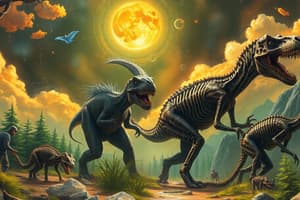Podcast
Questions and Answers
What does the theory of evolution by natural selection explain?
What does the theory of evolution by natural selection explain?
- How certain traits become advantageous and are passed to future generations. (correct)
- How all offspring have an equal chance of survival.
- How environmental changes have no effect on species.
- How populations can maintain stability over time.
Which scientific field studies fossils to understand species' changes over time?
Which scientific field studies fossils to understand species' changes over time?
- Biogeography
- Comparative anatomy
- Molecular biology
- Paleontology (correct)
What term describes the ability of an individual to survive in its environment?
What term describes the ability of an individual to survive in its environment?
- Fitness (correct)
- Adaptation
- Survival rate
- Genetic variability
Which of the following is a key concept of Darwin's theory introduced in 'The Origin of Species'?
Which of the following is a key concept of Darwin's theory introduced in 'The Origin of Species'?
What do adaptations refer to in the context of evolution?
What do adaptations refer to in the context of evolution?
What significant idea was introduced in Charles Darwin's 'The Descent of Man'?
What significant idea was introduced in Charles Darwin's 'The Descent of Man'?
How long did Darwin wait before publicly presenting his theory of evolution?
How long did Darwin wait before publicly presenting his theory of evolution?
What is the primary focus of organismal ecology?
What is the primary focus of organismal ecology?
Which level of ecological study includes both biotic and abiotic factors?
Which level of ecological study includes both biotic and abiotic factors?
How does population density change within an ecosystem?
How does population density change within an ecosystem?
Which of the following statements about food chains and food webs is correct?
Which of the following statements about food chains and food webs is correct?
What does biotic potential refer to?
What does biotic potential refer to?
What defines the carrying capacity of an ecosystem?
What defines the carrying capacity of an ecosystem?
Which of these is an example of a density-dependent factor affecting population growth?
Which of these is an example of a density-dependent factor affecting population growth?
What role do producers play in an ecosystem?
What role do producers play in an ecosystem?
What is a key distinction between an ecosystem and an environment?
What is a key distinction between an ecosystem and an environment?
What role does natural selection play in animal populations?
What role does natural selection play in animal populations?
Which statement accurately describes mutations?
Which statement accurately describes mutations?
What is the difference between allopatric and sympatric speciation?
What is the difference between allopatric and sympatric speciation?
During the Industrial Revolution, how did the color variation of the peppered moth population demonstrate natural selection?
During the Industrial Revolution, how did the color variation of the peppered moth population demonstrate natural selection?
Which components are included in the environment of an organism?
Which components are included in the environment of an organism?
What defines a species in biological terms?
What defines a species in biological terms?
Which statement best describes the concept of evolutionary rescue?
Which statement best describes the concept of evolutionary rescue?
What triggers the process of speciation?
What triggers the process of speciation?
How do structural adaptations differ from behavioral adaptations?
How do structural adaptations differ from behavioral adaptations?
Flashcards are hidden until you start studying
Study Notes
Theory of Evolution
- Overwhelming support from various scientific fields for the theory of evolution.
- Paleontology studies how species evolve through the fossil record.
- Biogeography examines species distribution geographically, explaining varied ecosystems.
- Comparative anatomy compares homologous structures across organisms, linking environmental changes to physical traits.
- Molecular biology uncovers evolutionary changes at the genetic level.
Charles Darwin's Contributions
- Notable biologist known for his voyage on the HMS Beagle, collecting crucial data.
- Introduced the theory of evolution by natural selection, highlighting survival advantages of certain traits.
- Fitness refers to an individual's ability to survive and reproduce; "survival of the fittest" emphasizes the role of advantageous traits.
- Adaptations are inheritable traits that enhance survival, passed down through generations (descent with modification).
- Published "On the Origin of Species" in 1859, a bestseller that sparked revolutionary scientific discussions, followed by "The Descent of Man" addressing sexual selection.
Natural Selection and Mutation
- Natural selection drives changes in populations based on advantageous traits suited to the environment.
- New traits arise only through mutations, which can be beneficial, harmful, or neutral, leading to evolutionary changes.
- Environmental factors such as climate, predators, and resources heavily influence natural selection.
Environmental Influence on Species
- Environment encompasses biotic (living) and abiotic (non-living) factors.
- Environmental changes can be rapid (droughts, fires) or prolonged (ecosystem overhauls).
- Mutations lead to adaptations, which can be structural or behavioral, improving survival chances.
- Evolutionary rescue enables fast adaptation under changing environmental conditions.
Case Study: Peppered Moths
- Industrial pollution shifted survival advantage from light to dark-colored moths due to camouflage changes.
- Demonstrates natural selection in response to drastic environmental changes during the Industrial Revolution.
Speciation Mechanics
- A species is capable of naturally reproducing and producing fertile offspring.
- Speciation occurs through allopatric (geographic isolation) and sympatric (selective pressures without physical separation) processes.
- Reinforcement strengthens reproductive barriers, while sexual selection fosters trait preferences within populations.
Ecology Concepts
- Ecology studies organisms and their interactions within biotic and abiotic components at multiple levels: organismal, population, community, ecosystem, and biosphere ecology.
- Ecosystems consist of interacting biotic and abiotic factors, while the environment includes all components regardless of interaction.
Ecosystem Dynamics
- Ecosystems involve dynamic interactions between various organisms and their habitats.
- Habitat is suitable for organisms, while a niche defines their ecological role.
- Population density is influenced by biotic factors (competition, predation) and abiotic factors (climate, resources).
Energy Flow in Ecosystems
- Food chains depict direct energy transfer, while food webs illustrate complex interconnections among species.
- Producers form the base of trophic levels; energy flow from producers to consumers (herbivores to carnivores) is approximately 10% efficient.
Biotic Potential and Carrying Capacity
- Biotic potential reflects maximum reproduction rates under optimal conditions; varies across species.
- Carrying capacity refers to the sustainable population size in an ecosystem, determined by environmental resistance factors.
Influences on Population Size
- Numerous factors influence population sizes: nutrition, light availability, climate extremes, competition, predation, and symbiotic relationships (commensalism, parasitism, mutualism).
Behavioral Ecology
- Behavioral ecology studies the evolutionary basis of animal behavior and its ecological effects.
- Territoriality and mating choices are shaped by survival needs and ecological pressures.
Biodiversity Measurement
- Biodiversity includes species, genetic, and ecological variations.
- High biodiversity fosters ecosystem stability and resilience, promoting recovery from disturbances.
Threats to Biodiversity
- Deforestation, overfishing, wetland drainage, damming, poaching, invasive species, and pollution threaten diverse ecosystems.
- Climate change impacts natural habitats and species survival.
Ecosystem Balance and Disturbances
- Ecosystem balance relies on stable interactions; natural and human disturbances can disrupt this equilibrium.
- Natural disturbances may include fires, floods, and climate shifts, while human activities may lead to lasting ecosystem changes.
Studying That Suits You
Use AI to generate personalized quizzes and flashcards to suit your learning preferences.




